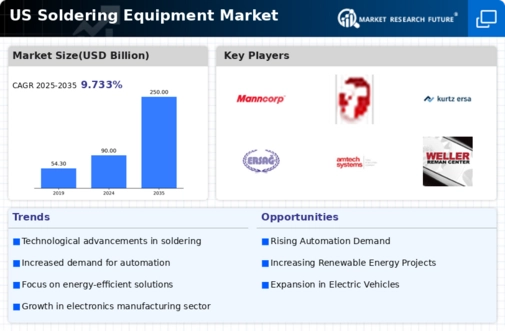Expansion of Automotive Industry
The expansion of the automotive industry in the US significantly impacts the soldering equipment market. With the increasing production of electric vehicles (EVs) and the integration of advanced electronics in traditional vehicles, the demand for reliable soldering solutions is on the rise. In 2025, the automotive sector is expected to contribute over $1 trillion to the US economy, with a substantial portion allocated to electronic components. This growth necessitates the use of sophisticated soldering equipment to ensure the durability and performance of automotive electronics. Additionally, the shift towards automation in automotive manufacturing processes is likely to drive the adoption of advanced soldering technologies, thereby enhancing the soldering equipment market's prospects. As manufacturers strive to meet stringent safety and quality standards, the demand for high-performance soldering solutions will likely continue to grow.
Growth in Renewable Energy Sector
The growth in the renewable energy sector is emerging as a significant driver for the soldering equipment market. As the US transitions towards sustainable energy sources, the production of solar panels and wind turbines is increasing. In 2025, the renewable energy market is projected to exceed $200 billion, creating a substantial demand for soldering equipment used in the assembly of photovoltaic cells and other components. This trend suggests that manufacturers will require advanced soldering technologies to ensure the reliability and efficiency of renewable energy systems. Moreover, the emphasis on energy efficiency and sustainability in production processes may lead to innovations in soldering techniques, further enhancing the soldering equipment market. As the renewable energy sector continues to expand, the need for high-quality soldering solutions will likely remain a key factor driving market growth.
Increasing Demand for Electronics
The growing demand for consumer electronics in the US is a primary driver for the soldering equipment market. As technology advances, the production of smartphones, tablets, and other electronic devices continues to rise. In 2025, the consumer electronics market is projected to reach approximately $400 billion, which directly influences the need for efficient soldering solutions. Manufacturers are increasingly investing in automated soldering processes to enhance production efficiency and reduce costs. This trend indicates a robust growth trajectory for the soldering equipment market, as companies seek to meet the rising demand for high-quality electronic products. Furthermore, the integration of advanced soldering technologies, such as laser soldering and selective soldering, is likely to further propel market growth, as these methods offer precision and reliability in electronic assembly.
Investment in Research and Development
Investment in research and development (R&D) within the soldering equipment market is a vital driver of growth. Companies are increasingly focusing on developing innovative soldering technologies to enhance efficiency and reduce production costs. In 2025, R&D spending in the manufacturing sector is projected to reach $100 billion, with a notable portion directed towards soldering equipment advancements. This investment is likely to lead to the introduction of new materials and techniques, such as lead-free soldering and advanced flux formulations, which can improve the performance and reliability of solder joints. Furthermore, as industries strive to meet evolving regulatory standards and consumer demands, the emphasis on R&D will likely continue to shape the soldering equipment market. The ongoing pursuit of innovation in soldering technologies may result in enhanced product offerings and increased market competitiveness.
Rising Complexity of Electronic Assemblies
The rising complexity of electronic assemblies is a crucial driver for the soldering equipment market. As devices become more sophisticated, the need for precise and reliable soldering techniques increases. In 2025, the trend towards miniaturization in electronics is expected to continue, with manufacturers requiring advanced soldering solutions to accommodate smaller components and tighter tolerances. This complexity necessitates the use of specialized soldering equipment, such as reflow ovens and wave soldering machines, which can handle intricate assembly processes. Additionally, the integration of smart technologies in various industries, including healthcare and telecommunications, further emphasizes the need for high-quality soldering solutions. As the demand for complex electronic assemblies grows, the soldering equipment market is likely to experience significant expansion, driven by the need for precision and reliability in manufacturing.



















Leave a Comment